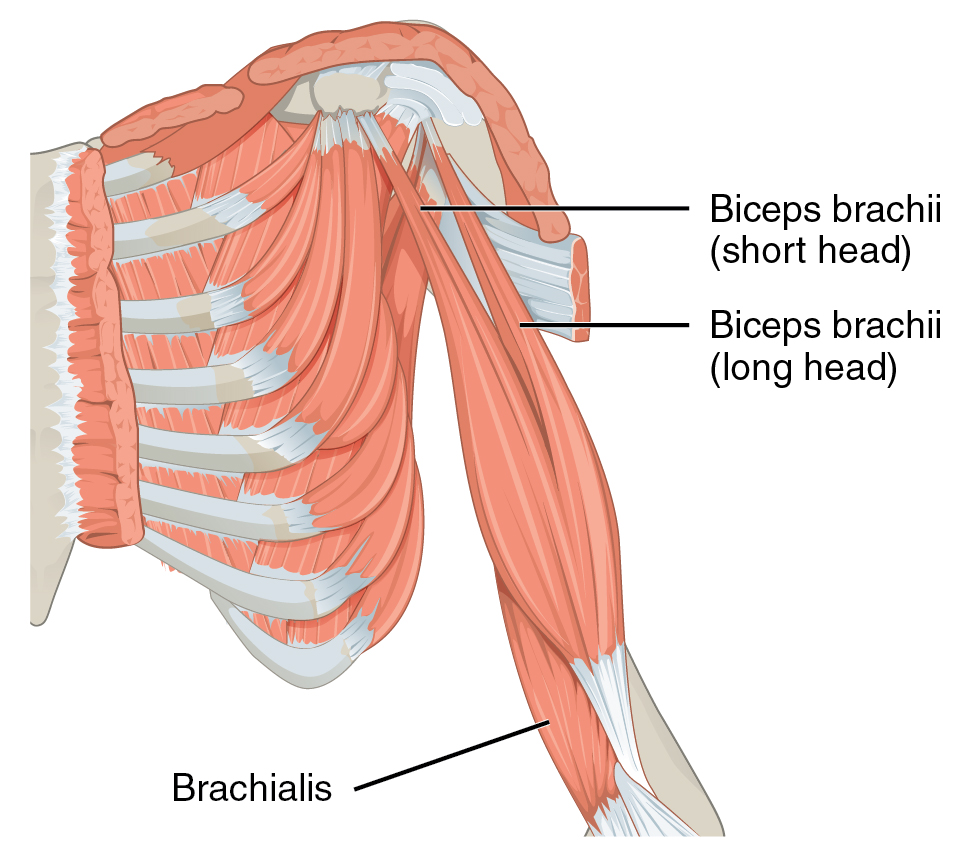 The brachialis runs from the lower, front part of the upper arm, across the elbow to the middle of the forearm. It provides most of the strength for elbow flexion. When you do a biceps curl, you are primarily exercising your brachialis. However, when your forearm is fixed, the brachialis rotates the upper arm toward the forearm, as in an overhand pull-up.
The brachialis runs from the lower, front part of the upper arm, across the elbow to the middle of the forearm. It provides most of the strength for elbow flexion. When you do a biceps curl, you are primarily exercising your brachialis. However, when your forearm is fixed, the brachialis rotates the upper arm toward the forearm, as in an overhand pull-up.
It is often said that the biceps are for show and the brachialis is for go.
Pain from brachialis trigger points refers mainly to the base of the thumb. Use of your thumb may aggravate it. You may also experience pain in the crook of your elbow. Pain referred into the shoulder does not impair shoulder movement.
Brachialis trigger points are typically activated from stress overload of elbow flexion. This can include activities as diverse as using a power tool, carrying groceries, ironing, playing a musical instrument, or typing when too close to the keyboard. Activities such as rowing, pull-ups or backhand tennis strokes can activate brachialis.
In “tennis elbow”, brachialis trigger points can develop after a supinator activation, along with trigger points in the biceps.
Corrective actions include trigger point pressure release, stretching, and avoiding activities that overload the muscle, such as elbow flexion, turning your hands down when lifting, and sleeping with the arms flexed.
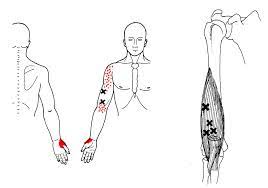 If you maintain a posture or activity that activates a trigger point in any muscle it will continue.
If you maintain a posture or activity that activates a trigger point in any muscle it will continue.
 Brachialis trigger points are typically activated from continued stress overload of elbow flexion. This means either repeatedly flexing your elbow or keeping it flexed for a prolonged period of time, including both active and passive flexion. This can include activities as diverse as carrying groceries, driving, ironing, playing a musical instrument, or typing when too close to the keyboard.
Brachialis trigger points are typically activated from continued stress overload of elbow flexion. This means either repeatedly flexing your elbow or keeping it flexed for a prolonged period of time, including both active and passive flexion. This can include activities as diverse as carrying groceries, driving, ironing, playing a musical instrument, or typing when too close to the keyboard.
 In an activity such as violin playing, we can see that both elbows are flexed, with the non-dominant support arm especially disadvantaged.
In an activity such as violin playing, we can see that both elbows are flexed, with the non-dominant support arm especially disadvantaged.
With “tennis elbow”, brachialis trigger points can develop after a supinator (forearm rotator) activation, along with trigger points in the biceps.
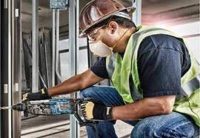 You may also have trouble after episodic elbow flexion loads such as using a power tool. In this example, the flexed arm is also provide the force behind the tool, requiring bracing of the entire arm/shoulder/neck chain.
You may also have trouble after episodic elbow flexion loads such as using a power tool. In this example, the flexed arm is also provide the force behind the tool, requiring bracing of the entire arm/shoulder/neck chain.
 Placing any muscle in a shortened or lengthened position for an extended period of time can also activate trigger points in the muscle. This happens most often when we are sleeping, but can happen during a variety of other activities too.
Placing any muscle in a shortened or lengthened position for an extended period of time can also activate trigger points in the muscle. This happens most often when we are sleeping, but can happen during a variety of other activities too.
Prolonged flexion of your elbow, either during anything a local phone call or carrying a purse incorrectly to sleep or a surgical procedure, can activate trigger points in the brachialis.
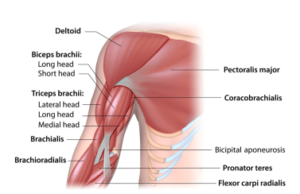 Myofascial self-care always starts with establishing a foundation of diaphragmatic breathing. Once you have taken a few moments to get in touch with your breath, we move on to self-compression and stretching. You may find that a warm bath or shower, or applying moist heat before you begin is helpful.
Myofascial self-care always starts with establishing a foundation of diaphragmatic breathing. Once you have taken a few moments to get in touch with your breath, we move on to self-compression and stretching. You may find that a warm bath or shower, or applying moist heat before you begin is helpful.
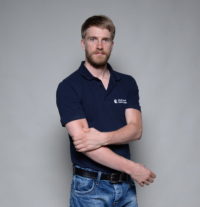 You can use pressure self-release for the brachialis while seated, standing, or in side-lying positions.
You can use pressure self-release for the brachialis while seated, standing, or in side-lying positions.
Using your hand from the unaffected side, begin by using your fist to gently massage the area just above the elbow. Explore the muscle, note areas that are sorer, and bring your focus to them. To compress specific trigger points, use the knuckle (or thumb) of the forefinger from the unaffected side to probe deeper. Find the tender spot and apply pressure for up to 30 seconds as pain decreases. You can do this three to five times. Repeat this compression in other positions as you flex your elbow.
Many blood vessels and nerves in the arm are superficial, so pressure self-release should be done with caution. If you feel tingling or circulation changes in your hand you should reposition and take a different approach.
After completing self-compressions, move your arm through its range of motion and prepare to gently stretch your brachialis.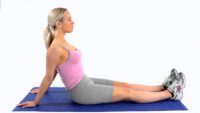
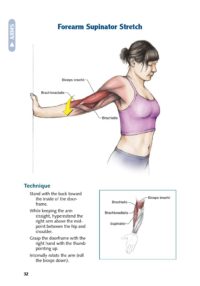 The illustrations of forearm stretches that also work on brachialis are from the book “Stretching Anatomy”, widely available and highly recommended.
The illustrations of forearm stretches that also work on brachialis are from the book “Stretching Anatomy”, widely available and highly recommended.
You can use your breath to deepen the stretch. Begin with a generous inhale and as you exhale, gently stretch by rotating the body away from the doorframe. You can repeat this sequence three to five times, up to four times per day.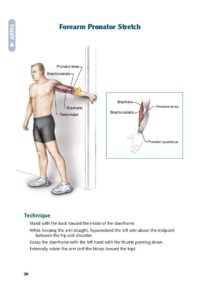
If you experience pain following pressure release and stretching, a cold pack may be helpful.
Note that some people find aggressive release and stretching of the brachialis is counter-productive. An alternative, gentle approach is to extend your arm, supported on a pillow just above the elbow. Use just the force of gravity to provide load as you resist isometrically without any assistance from the other hand.
Begin to time these cycles with your breath, relaxing as much as possible. Once relaxed, use your unaffected hand to provide gentle resistance as you continue to contract and relax, in coordination with your breath. You can do this twice a day after applying moist heat.
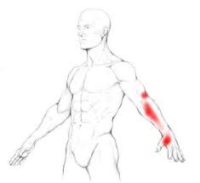 Pain at the base of the thumb, extending up through the forearm to the elbow, is typical of brachialis trigger points. Pain is usually concentrated thumb and may pass over the wrist to the forearm. Pain in the crook of your elbow can also happen. There may be some pain in the front of your shoulder but it does not affect movement.
Pain at the base of the thumb, extending up through the forearm to the elbow, is typical of brachialis trigger points. Pain is usually concentrated thumb and may pass over the wrist to the forearm. Pain in the crook of your elbow can also happen. There may be some pain in the front of your shoulder but it does not affect movement.
Restriction in elbow extension, if any, is usually slight.
 Moving your thumb may be painful, but flexing the elbow often is not. You may experience weakness in forearm flexion from inhibition of the brachialis.
Moving your thumb may be painful, but flexing the elbow often is not. You may experience weakness in forearm flexion from inhibition of the brachialis.
Numbness, tingling, and sensory nerve pain can be caused by a brachialis trigger point entrapping the sensory branch of the radial nerve. Releasing this trigger point confirms the entrapment by relieving the symptoms.
The biceps may also become painful as the load is transferred from the weakened brachialis to the biceps. Note that carrying things with hands facing down favors the brachialis. Hands facing up favors the biceps. Carrying something heavy for a long time, with the forearms supinated and hands facing up can create a difficult trigger point activation that may not resolve without treatment.
 Avoid repetitive actions that overload the muscle, such as lifting heavy objects with your arms extended. When necessary, modify your lift to keep your palms facing up rather than down. Note that this shifts the load to your biceps. Consider a neutral hand position.
Avoid repetitive actions that overload the muscle, such as lifting heavy objects with your arms extended. When necessary, modify your lift to keep your palms facing up rather than down. Note that this shifts the load to your biceps. Consider a neutral hand position.
Brachialis trigger points do not usually interfere with sleep, but improper sleeping positions can activate them. The tendency to curl the arm in an up shortens the brachialis. It will help if you place a pillow inside your elbow to discourage elbow flexion, avoiding the prolonged shortening that can lead to pain.
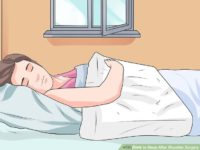 You can also use this technique to support the painful arm when sleeping on your back or when sitting.
You can also use this technique to support the painful arm when sleeping on your back or when sitting.
In general, do not sleep on your stomach.
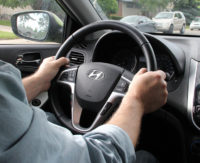 A similar problem occurs on long phone calls or carrying a purse with the elbow flexed. Driving in the “10 and 2” or “8 and 4” position also flexes the elbows and shortens brachialis. Note that the NHTSA recommends the more neutral “9 and 3” position for safety as well.
A similar problem occurs on long phone calls or carrying a purse with the elbow flexed. Driving in the “10 and 2” or “8 and 4” position also flexes the elbows and shortens brachialis. Note that the NHTSA recommends the more neutral “9 and 3” position for safety as well.
When playing a musical instrument such as the violin, piano, guitar, or trombone, the elbows are flexed and should be allowed to hang freely when possible. Sitting too close to your work when typing has a similar effect.
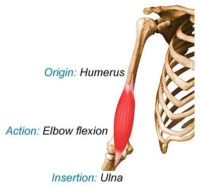 The brachialis crosses the elbow and its main function is to flex the forearm.
The brachialis crosses the elbow and its main function is to flex the forearm.
Unlike the biceps, the brachialis does not attach to the radius in the forearm. This means it does not actively participate in rotation (pronation and supination) of the forearm.
There is a delicate interplay between the brachialis, biceps brachii, and brachioradialis muscles during loaded flexion at the elbow.
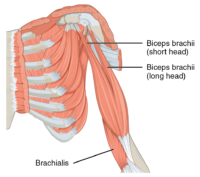 The biceps brachii is a large muscle on the front of the upper arm between the shoulder and the elbow. Both heads of the muscle arise on the shoulder blade and join to form a single muscle belly that is attached to the upper forearm.
The biceps brachii is a large muscle on the front of the upper arm between the shoulder and the elbow. Both heads of the muscle arise on the shoulder blade and join to form a single muscle belly that is attached to the upper forearm.
Structure
The brachialis originates from the anterior surface of the distal half of the humerus (upper arm), near the insertion of the deltoid muscles, which it embraces by two angular processes. Its origin extends below to within 1 inch of the margin of the joint surfaces of the humerus at the elbow joint. Its fibers converge to a thick tendon, which is inserted into the tuberosity of the ulna and the rough depression on the front surface of the coronoid process of the ulna.
Nerve supply
The brachialis muscle is innervated by the musculocutaneous nerve, which runs on its superficial surface, between it and the biceps brachii. However, in 70-80% of people, the muscle has double innervation with the radial nerve (C5-T1). The divide between the two innervations is at the insertion of the deltoid.
Variation
The muscle is occasionally doubled; additional muscle slips to the supinator, pronator teres, biceps brachii, lacertus fibrosus, or radius are more rarely found.
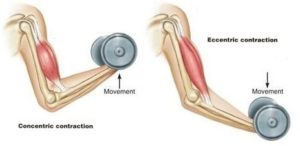 For example, in a biceps curl, you would use a concentric contraction of your biceps, coupled with an eccentric contraction of your triceps, to flex your elbow and push the weight up. As you lower the weight, eccentric contractions of your biceps are required to maintain control and prevent dropping the weight.
For example, in a biceps curl, you would use a concentric contraction of your biceps, coupled with an eccentric contraction of your triceps, to flex your elbow and push the weight up. As you lower the weight, eccentric contractions of your biceps are required to maintain control and prevent dropping the weight.
Isotonic Contractions
Isotonic contractions maintain constant tension in the muscle as the muscle changes length. This can occur only when a muscle’s maximal force of contraction exceeds the total load on the muscle. Isotonic muscle contractions can be either concentric (muscle shortens) or eccentric (muscle lengthens).Concentric Contractions
A concentric contraction is a type of muscle contraction in which the muscle shortens while generating force. This is typical of muscles that contract due to the sliding filament mechanism, and it occurs throughout the muscle. Such contractions also alter the angle of the joints to which the muscles are attached.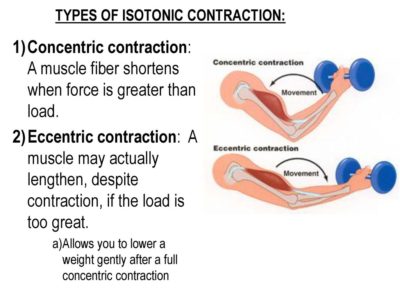 This occurs throughout the length of the muscle, generating force; causing the muscle to shorten and the angle of the joint to change. For instance, a concentric contraction of the biceps would cause the arm to bend at the elbow as the hand moves close to the shoulder (a biceps curl).
A concentric contraction of the triceps would change the angle of the joint in the opposite direction, straightening the arm and moving the hand away from the shoulder.
This occurs throughout the length of the muscle, generating force; causing the muscle to shorten and the angle of the joint to change. For instance, a concentric contraction of the biceps would cause the arm to bend at the elbow as the hand moves close to the shoulder (a biceps curl).
A concentric contraction of the triceps would change the angle of the joint in the opposite direction, straightening the arm and moving the hand away from the shoulder.
Eccentric Contractions
An eccentric contraction results in the lengthening of a muscle. These contractions decelerate muscles and joints (acting as “brakes” to concentric contractions) and can alter the position of the load force. During an eccentric contraction, the muscle lengthens while under tension due to an opposing force that is greater than the force generated by the muscle. However, rather than working to pull a joint in the direction of the muscle contraction, the muscle acts to decelerate the joint at the end of a movement or otherwise control the repositioning of a load. This can occur involuntarily (when attempting to move a weight too heavy for the muscle to lift) or voluntarily (when the muscle is “smoothing out” a movement). Strength training involving both eccentric and concentric contractions appears to increase muscular strength and joint stability more than training with concentric contractions alone.Isometric Contractions
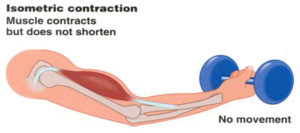 In contrast to isotonic contractions, isometric contractions generate force without changing the length of the muscle. This is typical of muscles found in the hands and forearm: the muscles do not change length, and joints are not moved, so force for grip is sufficient. An example is when the muscles of the hand and forearm grip an object; the joints of the hand do not move, but muscles generate sufficient force to prevent the object from being dropped.
For people with hypermobile joints, strength training can be a challenge. Tension stresses the connective tissues of the joint as force is transmitted through its range of motion. Isometric exercises can be ideal in these circumstances because there is minimal movement. This means that the joint is placed into vulnerable hyperextended positions under force.
In contrast to isotonic contractions, isometric contractions generate force without changing the length of the muscle. This is typical of muscles found in the hands and forearm: the muscles do not change length, and joints are not moved, so force for grip is sufficient. An example is when the muscles of the hand and forearm grip an object; the joints of the hand do not move, but muscles generate sufficient force to prevent the object from being dropped.
For people with hypermobile joints, strength training can be a challenge. Tension stresses the connective tissues of the joint as force is transmitted through its range of motion. Isometric exercises can be ideal in these circumstances because there is minimal movement. This means that the joint is placed into vulnerable hyperextended positions under force.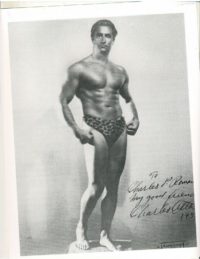 You can develop amazing strength without free weights, machines, or resistance bands.
One of the original bodybuilder gurus from the 1920s, Charles Atlas, based his workouts primarily on isometric exercises, eventually even trademarking a term for his exercise method that he called "Dynamic Tension."
If you have hypermobile joints you can strength train safely at home with isometric exercises.
You can develop amazing strength without free weights, machines, or resistance bands.
One of the original bodybuilder gurus from the 1920s, Charles Atlas, based his workouts primarily on isometric exercises, eventually even trademarking a term for his exercise method that he called "Dynamic Tension."
If you have hypermobile joints you can strength train safely at home with isometric exercises.
